Feature Interview with Bill Coore
November 1999
Bill Coore grew up in North Carolina and was graduated from Wake Forest, sowing the early seeds of his fondness for the work of Perry Maxwell (whose Old Town Club is in Winston-Salem). Like many of today’s top designers, Coore cut his teeth in the architecture business by working with Pete Dye before forming his own firm in 1982. In 1986 he formed a partnership with Ben Crenshaw. Coore and Crenshaw started off with several restoration projects before gradually building more and more of their own courses.
Today, the firm of Coore and Crenshaw is the most sought-after group in course design. Why? The quality of their work. Coore and Crenshaw adopt the philosophy of Charles Winchester from M*A*S*H: Do one thing at a time, do it very well and then move on. This approach explains both the consistently high quality of their work and, compared to other current architects, the relatively few courses they have designed. To top it off, Bill Coore and Ben Crenshaw are genuinely nice people “ who would not want these two gentlemen to build their new course?
1.Which three architects’ (past or present) body of work do you admire the most and why?
It would be impossible for me to limit my personal favorites to three. There were so many wonderful architects in years past whose talents I revere and people practicing today whose works I appreciate that I must exceed my limit. Even then, how can any past list not include names like A.W. Tillinghast, Tom Simpson or Harry Colt; or any present list not include Tom Fazio or other successful and talented designers? Anyway, my personal favorites are:
Past

A great start for golf in the United States - National Golf Links of America.
- C.B. Macdonald and Seth Raynor “ for their abilities to guide early American designs in the right direction.
- Alister MacKenzie “ for his artistry and imaginative designs.
- Perry Maxwell “ for his routings and magnificent greens contouring.
- Donald Ross “ for his simplicity and effectiveness for golf.
Present
- Pete Dye “ for his imaginative designs that work for golf regardless of their eccentricities; and his influence as the dominant golf architect of the past quarter century.
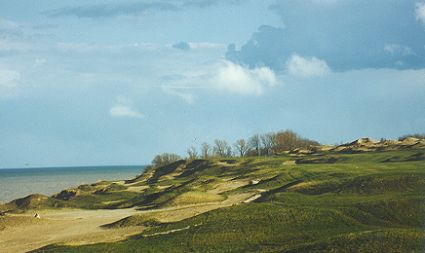
Whistling Straits under construction - one of Dye's most imaginative designs.
- Tom Doak “ for his talent and his potential to create courses like those men named in my ‘past’ list.
- Rod Whitman “ Well, I suppose I’m throwing everyone a curve here; but in my prejudiced opinion (Rod is a very good friend), if the ability to create a wonderful product on the ground were the sole measure of success in this business, Rod Whitman of Alberta, Canada would be highly acclaimed instead of unknown.
2. Sand Hills occupies ideal land for golf while the Plantation Course at Kapalua is set on an extreme piece of property. Both courses at Talking Stick are laid over essentially flat, featureless property. Does the satisfaction differ from a job well done on different properties? If so, how?
Absolutely. One of the great joys of practicing golf architecture is the chance to work with varying properties in terms of their natural features, vegetation and environment.
With regard to the courses you listed, the challenges faced and satisfaction gained from working with each site were markedly different.
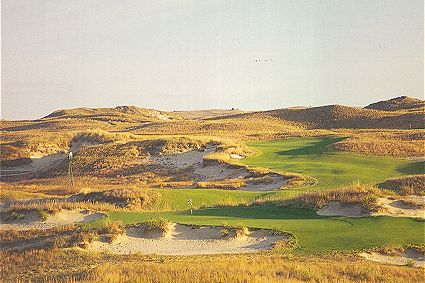
The rolling sand hills near Mullen
As you mentioned, the Sand Hills site was ideal. The challenge there was to create a course equal to the potential of the land “ a daunting task to say the least! To have constructed anything less than an extraordinary golf course on that site would have been a failure.
At Kapalua, we knew that due to the spectacular nature of the site, the course would be beautiful. Aesthetics were not a problem. Playability was. Whether the course would function for golf given the extremes of slope and wind associated with the site was the question.
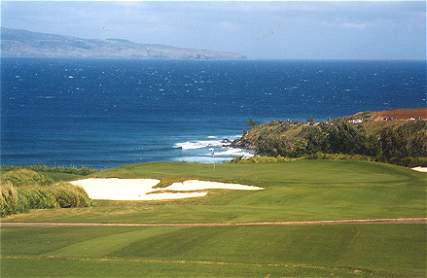
The picture perfect 11th at Kapalua.
People have asked how we who supposedly look for good natural sites for golf could have accepted the commission at Talking Stick on such an unpromising property.
The fact was that from our perspective it was attractive. The site was not severe “ it was totally flat! The owner wanted public golf, walking golf at that, no real estate and they had retained Troon Golf Management, a company that we had wanted to work with to manage the courses. In addition, we had just worked with one of the world’s great sites (Sand Hills) and a very good site for golf at Cuscowilla in Georgia. At each of these, the land dictated the routing and the concept of the holes. At Talking Stick we had the opportunity to create any sort of theoretical holes suited for flat ground, something we had wanted to do for some time.
At The Sand Hills, we had the greatest of canvases with a masterpiece hidden within. It was our task to uncover it. At Kapalua, we had to envision and create golf on a site not naturally suited for the game. At Talking Stick, we were given the blankest of canvases and total freedom to create from our imaginations.
The overall satisfaction of knowing that it is within our abilities to produce sound, interesting golf courses using these extremes is immeasurable.
3.If time and expense weren’t considerations, which five courses would you most like to see for the first time?
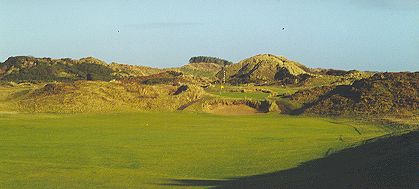
A must see - the rugged County Down.
- Royal County Down.
- Royal Dornoch.
- Machrihanish.
- The Creek.
- Cape Breton Highlands.
4.What do you think is the maximum number of projects that a design firm should have going at any one time?
I suppose that would be relative to the design forms involved and the number and skill levels of the design associates working on the projects.
Our comfort level is from one to three courses under construction at any one time, with two being our ideal. Actually, one would be our ideal but the uncertainties associated with permitting and scheduling seems to make that an impossible goal.
Larger firms could obviously undertake more projects, although I believe that no one person can be in charge of more than three or four golf courses and be fulfilling his (her) or the projects’ potential. I object to the perception that any one person no matter how gifted is personally and solely six or more golf courses at one time. Think of it, a hundred or more diverse and interesting holes to conceive simultaneously!!
Since I’m on my soapbox and off on a tangent, I must say that although I personally benefit from its existence, I struggle with the ‘designer label’ aspect of this business, and the perception that to have a successful project, an owner has to have a big name or big firm architect.
Certainly, an owner needs a skilled and creative architect with experience, but if it were not for the need of a ‘name,’ there would likely be more designers working in the field and more variety in the courses created. There are some really talented people out there who may never get an opportunity because of the pressure on owners to go with what ‘sells.’
5.What five holes (from different courses) do you wish you could say you designed?
- National Golf Links of America #3 “ I wish I had the imagination to see it on the ground and the courage to build it.
- Kingston Heath #15.
- Cypress Point #9.
- Royal Melbourne #5 (Composite).
- Almost any hole at Pine Valley.
6.What factors influence your design style the most?
- The land.
- The concept of the course (golf only, private, walking, etc.).
- The owners’ needs and desires.
- The clientele.
- Our previous projects “ we try to vary our styles to keep our designs interesting and to lessen the chance of our becoming redundant or stagnant.
7.What courses will be opening for Coore and Crenshaw in the year 2000? Please describe the key features in each.
Due to construction and grow-in schedules, 2000 may mark the first year that we have ever opened four golf courses in the same year. We had no openings in 1999.
The Warren Golf Course at the University of Notre Dame and the East Hampton Golf Club in East Hampton, NY will be opening in the spring of 2000. If all goes well, the two courses that we are currently working on, The Austin Golf Club in Austin, Texas, and the Chechessee Creek Club at Spring Island, SC should open in the fall.

The sixteenth at Notre Dame.
The University of Notre Dame course is an old-fashioned, straightforward design relying on sound shotmaking and subtlety “ a course that we hope matches the understated quality of the University itself.
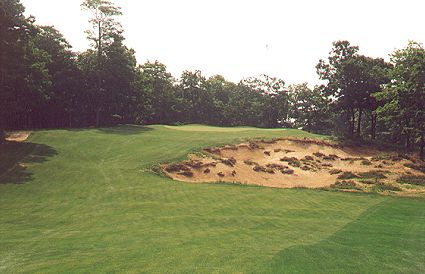
The natural sandy hazards at East Hampton.
The East Hampton Golf Club is a short but visually stunning golf course containing holes with natural sandy hazards reminiscent of Pine Valley and open meadows that may call to mind Garden City. It is a walking course with no cart paths.

The sixth at East Hampton.
The Austin Golf Club will be a solid test of golf based upon subtle yet effective natural contours and wind angles. This is the course that Ben has wanted to design in Texas for many years.
Chechessee Creek will be a golf only club set among the magnificent oaks and pines of the South Carolina Lowcountry. While it is not a copy of his designs, it is a tribute to Seth Raynor and early golf in coastal South Carolina.
8.What is your favorite short par 3 (under 140 yards), par 4 (under 340 yards) and par 5 (under 500 yards) in golf?
Par three: Pine Valley #10 “ but I wish the Club would restore the front bunker to its original eroded look.
Par four: Royal Melbourne #8Composite/#10 West.
Par five: Augusta National #13 “ the short par five is perhaps the most difficult type hole in all of golf to design so that it functions for all classes of golfers. The thirteenth at Augusta does it so well that everyone seems to want a similar hole on every course.
9.What course is a personal favorite with which the readers may not be familiar? What do you like about it so much?
Old Town Club in Winston-Salem, North Carolina is a favorite. It is a textbook on how to route a course over hilly terrain and had one of the finest sets of intact Perry Maxwell greens in America. I say ‘had’ because the greens have recently been rebuilt and I have not seen the finished product.
From a highly prejudiced perspective, I would list Rockport C.C. in Rockport, Texas. This was my first individual golf design, the place where the foundation of our present team of associates was assembled and the course that led to Ben’s and my partnership.
While it was far from perfect, there are a number of wonderful holes and interesting greens. Rockport has deteriorated considerably since its opening in 1982, but it still holds a special place in my heart, as any ‘first born’ would.
10.Which five courses possess the most fascinating green complexes?
- St. Andrews.
- Pine Valley.
- Somerset Hills.
- Pinehurst No. 2.
- Royal Melbourne (especially considering the bunkers).
- Prairie Dunes (if we’re considering green contours alone).
11.Sand Hills and Cuscowilla are private clubs; Kapalua a resort; and Talking Stick a daily fee operation. Does your approach differ based on the clientele? As a follow-on question, if Kapalua were a private club with less than 100 rounds a day, would you have changed any of its design features?
While we try to create golf courses with character, aesthetic appeal and strategy regardless of who will be playing them, we certainly consider the clientele and the owners who will be operating the courses.
When designing a course for a private golf club with an avid, knowledgeable membership, design features may be considered that would not be workable on a public course hosting tens of thousands of rounds per year. The fact that the members will have the opportunity to discover the course’s nuances over a long period of time allows the use of less obvious strategies for play, more interesting bunkering, i.e., cross bunkering, occasional blind shots and less concern about golf holes in close proximity to one another. Also, on private courses, it is generally easier to design fairways and greens that ‘fit the shot.’ For example, pitch shot par threes and drive and pitch par fours generally call for smaller than average, often well-bunkered greens, the size and access of which would be prohibitive on public courses due to the number of rounds played, the pace of play and maintenance concerns.
Having said that, there is no reason that any well-designed course should be boring. Public access courses can and should be designed using the same general principles as those at the best private courses, only in a more judicious manner. Public courses hosting greater numbers of players with a greater variance in abilities require more room to play, more forgiving hazards and somewhat more apparent strategies. No course however should be so obvious as to reveal itself upon one viewing. Any course worth the effort of construction should have enough nuances of character and strategy to hold the players’ interest and maintain a sense of mystery and discovery over a long period.
As to your question about Kapalua, no, we would not have changed any of the design features had it been conceived as a private course. The extremes of wind and slope dictated the course’s expansive features and its strategies for play.
12.How many present day golf course architects’ work do you admire and make the effort to see?
There are probably three to four in any average year but the names may change from year to year given the type of work they are doing and how it relates to what we are doing. I must confess to being a preacher of the past. I tend to study more older courses than newer ones.
13.What five courses are ‘must sees’ for a student of golf course design?
- St. Andrews
- Pine Valley
- Royal Melbourne
- The National Golf Links of America
- Cypress Point
14.Some design firms are doing their best work overseas, simply because of the land that is being made available is so special. Recent examples include Weiskopf and Morrish at Loch Lomond, Nicklaus at Cabo del Sol and Doak in both Scotland and Australia. Do you think the firm of Coore and Crenshaw will ever undertake a project outside the United States?
Well, in fact, we have. In 1997 Klub Golf Rimba Irian, a course that we designed for Freeport McMoRan, opened in Irian Jaya, Indonesia. We designed the course in association with Rod Whitman of Alberta, Canada.
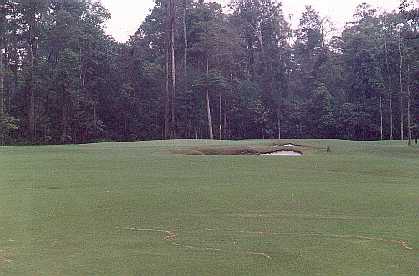
The 1st at Rimba Irian in Indonesia.
Rod and I also worked together on the Chateau course at Golf du Medoc in Bordeaux, France. Ben and I were partners at the time but due to other commitments, he was unable to be involved at Golf du Medoc. The Chateau course opened in 1987 and hosted the French Open Championship this past summer.

The first hole at Golf du Medoc.
We are extremely proud of these courses and in both instances, worked ever as hard on these far removed projects as those we have designed here in America; and therein lies the problem. For reasons of travel, time constraints and our commitments here, we find it very difficult to work abroad.
That does not mean that we would never work outside of America. We would certainly give consideration to an enticing opportunity on a piece of land well suited for golf.
15.Which five links courses do you most enjoy playing?
As strange as it may seem, I have played very little golf on links courses. I have walked a number of the most renowned links in Scotland and Ireland and am familiar with others through photographs, sketches and written materials. I have only played, however, the Old Course at St. Andrews, Prestwick and the original course at Ballybunion, each of which I enjoyed immensely. One of my absolute favorite courses is the National Golf Links of America, although I’m not sure that by the strictest definition it would be termed a ‘links’ course.
16.To the best of our knowledge, Coore and Crenshaw have done little restoration work and yet your appreciation and understanding of the traditional courses is well known. Is restoration work an area that you in general prefer to avoid?
In the early years of our company, the majority of our work was restoration oriented.
A partial list of courses on which we have worked would include:
- Brook Hollow Golf Club, Dallas, Texas;
- Lakewood C.C., Dallas, Texas;
- Prairie Dunes C.C., Hutchinson, Kansas;
- Riviera C.C., Pacific Palisades, California;
- The Houston C.C., Houston, Texas;
- Hot Springs C.C., The Arlington Course, Hot Springs, Arkansas;
- The Denver C.C., Denver, Colorado.
Hopefully, no one will ever know that we worked on these courses. The goal in restoration is just that “ restoration “ not to leave signatures.
While we are not opposed to undertaking restoration projects, in recent years, we have chosen to concentrate more on our new course opportunities. We are very grateful, however, for those clubs that afforded us the chance to first study and then work on their wonderful courses. These were invaluable lessons in architecture.
17. What are your five favorite books on golf course architecture?
- The Links by Robert Hunter;
- Golf Architecture in America by George Thomas;
- The Architectural Side of Golf by Wethered and Simpson;
- Scotland’s Gift “ Golf by C.B. Macdonald;
- The Golf Course by Whitten and Cornish.
18.How would you describe your relationship with Mr. Crenshaw? How, for instance, did you work together on Sand Hills?
Ours is a relationship based upon mutual respect and friendship. This December will mark our fourteenth year together. As with the most special things in life, it seems inconceivable that so much time has passed so quickly.
I have great admiration for Ben as a golfer and as a golf course designer, and I can say without hesitancy that my greatest admiration for him is as a person. In all the years that we have known one another, I have yet to see him conduct himself in any manner less than dignified.
With regard to architectural interaction, I think that we compliment one another. Ben brings to our business his understanding of the wonderful golf courses he has seen and studied as well as high sensitivity to the details of golf course strategy and contouring. Perhaps more than anything, I have learned from Ben that a subtle contour or the consideration of a wind angle will serve the purpose of good golf more than any heavy handed creation could ever achieve.
Our working relationship at The Sand Hills was basically the same as for all of our courses. We work together in evaluating the site and agreeing upon a routing. Obviously, because of time constraints and Ben’s other commitments, I have more time to spend on the site. For that reason, it is generally my role to select individual golf holes that could be a part of any potential routing. Together, we assess these and any other potential holes and select the ones that will become the course.

The end result of a perfect partnership.
After the routing is selected, we establish a general concept for the strategy and style of the individual holes and the course as a whole. This concept will include our thoughts regarding the holes’ strategy, the style of bunkering and the contouring of green sites and approaches. As much as the requirements for the permitting of the course will allow, we try to leave the details on contouring free to happen during the evolutionary process in the field.
From the start of construction on, ours is the job of establishing a starting point and giving guidance in the field. At times this guidance is specific, while at others it is minimal. We find ourselves editing the work of our associates in the field ever as much as directing it.
This process points to another of Ben’s assets, his insistence on being part of a team effort. We and our associates believe that collectively we are better than any one of us would be alone.
For me, being a part of this creative process whereby a team of extraordinarily talented individuals come together to rough in and then refine and polish into reality what began as only an idea is the highlight of golf course architecture.
19.Each course that you have done is markedly different, even the two side by side at Talking Stick. How do you keep coming up with fresh design ideas? What is an example of a design feature that you have just discovered in the past couple of years?
Thank you for the compliment. We try to make each of our courses interesting and different in terms of appearances and playing characteristics; but to my knowledge, we haven’t created any innovative design ideas or used any long forgotten features. We apply time proven design principles in varying arrangements, to create what we hope are sound, artistic and traditionally oriented golf courses. This process might be likened to musical composition. While there are no new notes, there are limitless ways to arrange those notes into a composition.
In our case, this is made easier by the fact that, normally, we ‘arrange’ only two compositions per year.
The End

